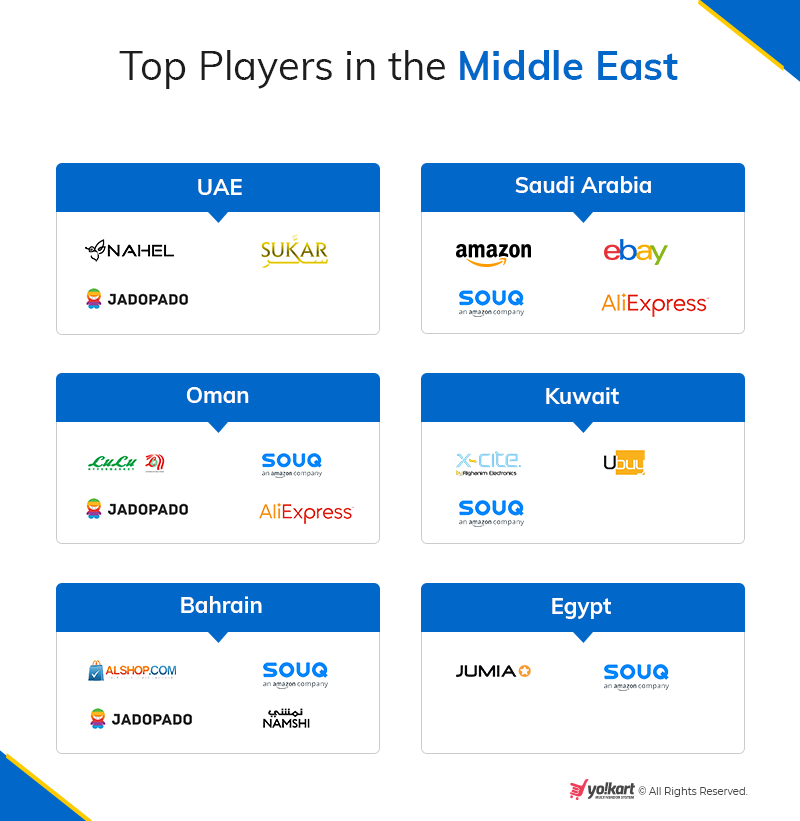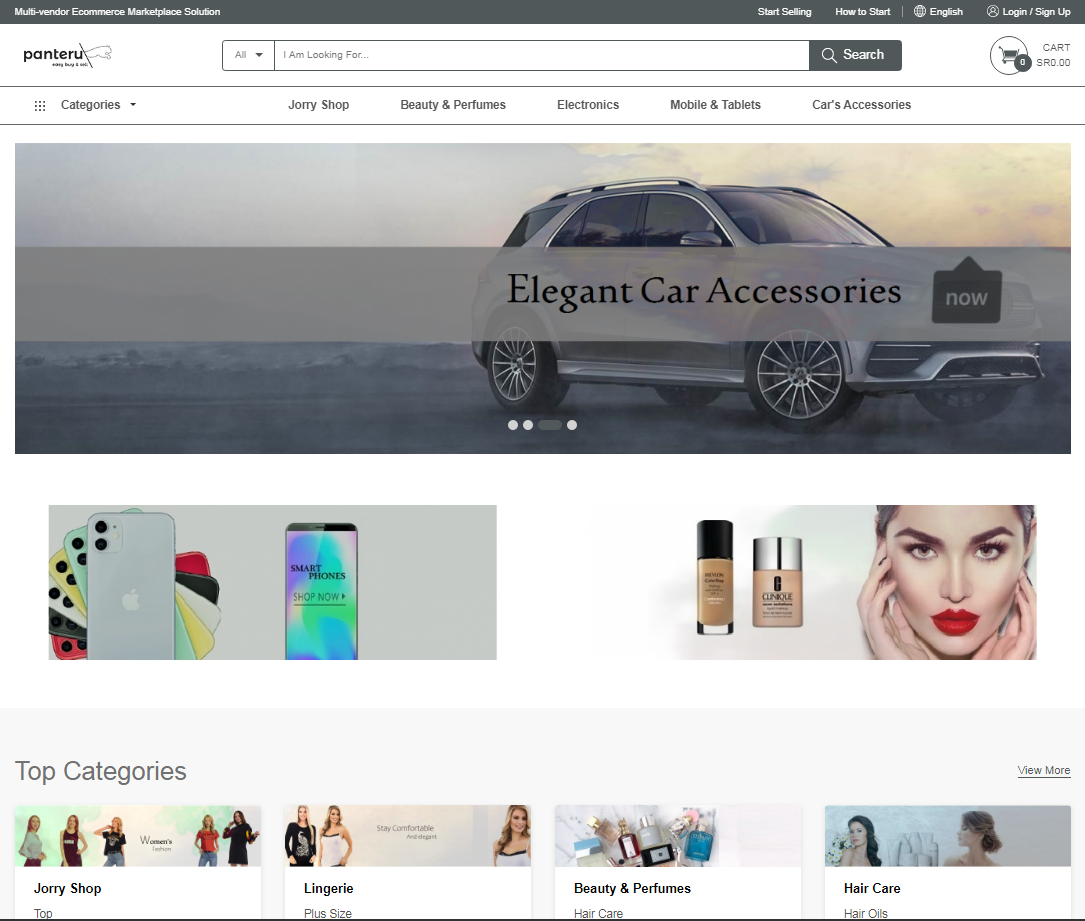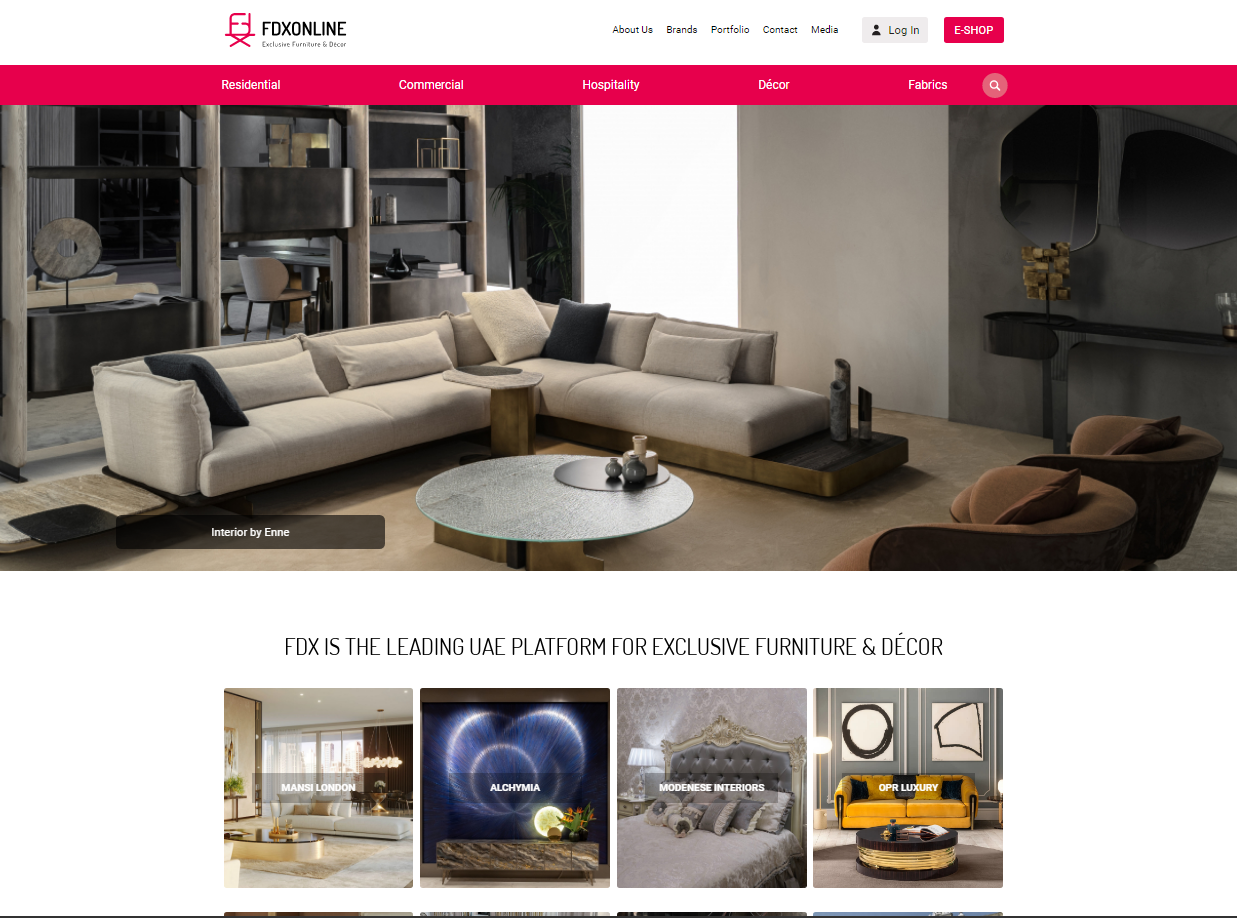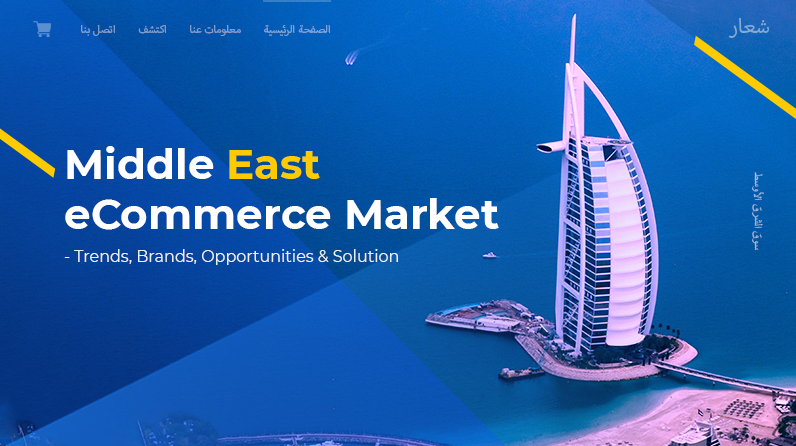Middle East Multi-Vendor eCommerce Outlook – Opportunities, Trends, Brands, Solution
The Middle East B2C eCommerce market is on the verge of a pivotal shift. “The Biggest M&A (Mergers and Acquisitions) deal in the Arab world i.e. Amazon’s acquisition of Souq.com is the proof of it.”
Further, the six-member states of the Gulf Cooperation Council (GCC) – Saudi Arabia, Kuwait, Oman, Qatar, Bahrain, and the United Arab Emirates (UAE) have undertaken globalization efforts to encourage online trade and facilitate foreign direct investment.
It reflects in the number as well. Online shopping has grown by 1500% in the Middle East over the last decade and the market is expected to reach US$69 billion mark by 2020.
The Middle East customers have an extensive appetite for purchasing both local & global brands online. This means more multi-vendor marketplace opportunities can be leveraged in the region.
Combining insights from FATbit’s association with top eCommerce businesses in the Middle-east region and secondary research, we access the current Middle-east eCommerce market dynamics to throw light on opportunities, trends, brands, and solutions. Following are the areas that we have covered in the post:
- Why Invest in the eCommerce Market of the Middle East?
- Leading Middle-Eastern eCommerce Trends
- Leading Middle-Eastern eCommerce Markets
- Creating a Multi-vendor Marketplace Platform for the Middle East
What Makes Middle East Market Best for Online Business?
Thanks to the high per capita income, the Middle-East is emerging as one of the fastest-growing markets in the world. There are multiple factors in favor of growth for the region. In the following lines, we will take a look at the latest eCommerce trends, key markets and key players involved in the Middle East markets.
Factors fueling eCommerce growth in the region:
The Middle East’s current internet penetration rate is 60 percent, well above the global average of 51.7 percent. Half of the population in the Middle Eastern countries is currently under the age of twenty-five. Also, the region has one of the highest social media penetration rates in the world. The young demographic spends more time on social media platforms which encourages marketers to use multiple channels to improve customer engagement on their eCommerce websites.
- The Middle East markets have a relaxed taxation system as compared to the European market.
- It is easy to identify the customer personas as the Arab consumers can be segmented with fewer efforts.
- Policies of many Middle East countries allow investors to repatriate their investments.
- The untapped potential for eCommerce players is huge. Till now online sales in the Middle East are only two percent of the overall retail sales.
In 2014, the UAE government set up a duty-free eCommerce hub known as Matajir.com to work closely with various international companies. This initiative helped in establishing Dubai as a global eCommerce marketplace.
Factors such as the readiness of Arab consumers to adopt new technologies and an increase in usage of mobile devices have positioned the Middle East for a digital transformation.
Governments of many Middle East countries are prepared to integrate paper-based information services (vehicle licensing, logistics tracking, passports/visa insurance, and utility payment) with universal online payment platforms. This step enables risk-free online shopping.
Launch a Successful Multi Vendor eCommerce Platform in the Middle East
eCommerce Trends in the Middle East
- Shift Towards Localization (An Alternative to Globalized Authoritarianism): To attract more local customers who refrained from online shopping because of language barriers, many luxury brands such as Dolce & Gabbana, Burberry, and the Blue Nile have launched their websites in Arabic.
- International Expansion Through Cross-Border eCommerce: According to a new report by Paypal and Ipsos, in 2017-2018, around 61 percent of UAE consumers bought items from foreign websites. The main reason behind it was the convenience and value provided by these websites along with free-shipping and payment gateway security.
- The Age of Social Media in the Middle East: Social media platforms such as Facebook, Instagram, and Twitter play an important role in influencing the e-shopping behavior of Arab consumers. The social media penetration rate is highest in Qatar and UAE at 99 percent.
- eCommerce Payment Space of the Middle East: There is no doubt that the region is still developing its payment infrastructure. But due to the growing eCommerce market, the governments of the Gulf region are taking many digitization initiatives to increase the use of online payment systems like net banking and digital wallets.
Leading eCommerce Markets in the Middle East
Saudi Arabia and the UAE are currently leading all the markets that come under the Gulf Cooperation Council (GCC). Other countries such as Qatar, Bahrain, Oman, and Kuwait also have remarkable eCommerce presence and growth but due to the low population, their contribution to the GCC is less.
Let’s take an in-depth look at some of the most important markets:
United Arab Emirates
According to the BMI stats, the UAE’s market size would be worth 45.6 percent of the total Middle East market by 2020. The tech-savvy cosmopolitan population makes the region favorable for eCommerce business.
Population and Internet Penetration
With a population of 9.5 million (median age of 33), the UAE is considered to be one of the world’s most urbanized countries. Also, with one of the youngest demographics in the Middle East, the country has an internet penetration of 85 percent.
What are Emirates’ Users Buying?
According to Retail Week, the UAE population spends $400 (USD) a month on online shopping. The travel market has the highest online market share with 67 percent. After travel, computer purchases rank second with an annual online spend of $136/AED 500.
How Do Emirates Shop?
- Cash on Delivery
- Credit or Debit Cards
- PayPal
Why Invest in the eCommerce Market of UAE?
The UAE is expected to generate 50 percent of eCommerce sales in the Middle-East. More than 60 percent of UAE customers buy things from international websites.
Also, the average amount of one online purchase in the UAE is more than $300. These stats are enough to prove why the UAE is poised to become the eCommerce capital of the Middle East.
Saudi Arabia
Currently, there are around 13 million eCommerce users in Saudi Arabia which makes it a huge market in the GCC.
Population and Internet Penetration
33.6 million people of Saudi have a median age of 30. Almost 80 percent of the total population uses the internet and 33 percent use an online marketplace for shopping.
What are the Saudis buying?
Like the UAE, the travel segment has the highest market share in Saudi with average annual online spending of $478/ SAR 1,793 per person.
How do the Saudis Shop?
- Cash On Delivery
- Credit or Debit Cards
- PayPal
Why Invest in the eCommerce Market of Saudi Arabia?
The Saudi Arabian eCommerce economy has experienced unprecedented growth over the past few years. The Saudi eCommerce ecosystem consists of B2C businesses, enterprise buyers, demand-side, supply-side, including traditional supply retailers, pure-play eCommerce providers, consumer-to-consumer sellers, small and medium enterprises (SMEs).
But, the lack of a strong and widely diverse domestic eCommerce industry has led to the consumers choosing from international brands that currently capture a significant portion of the revenue generated in Saudi Arabia.
This gives opportunities to regional offline stores to adopt an omnichannel approach and win the online market. The following are the reasons why one should transition into the eCommerce business in the Middle East:
- Logistics Sector Enhancement
- Ease of Doing Business
- Fostering Innovation and Entrepreneurship
- Boosting Local Industries
- Omnichannel and Digital Commerce Transformation of the Retail Industry
- More Connectivity and Broadband Coverage
- Card Payment Penetration for Online Payments
Leading eCommerce Players in the Middle East

Out of these, many eCommerce marketplaces are earning a huge profit which inspires entrepreneurs to start their multi-vendor marketplaces in UAE, Saudi Arabia, Oman, Qatar and Bahrain.
How to Create a Multi-vendor Marketplace in the Middle East (like Souq, AliExpress, and Awok)?
In the case of the Middle-East market, choosing a canned solution with the availability of a customization option is always a better choice. You can create a marketplace in the shortest possible time with all the essential features for profitable on-line trading.
Moreover, if a solution can develop your marketplace according to the Middle-East customers’ needs (language, payment options, etc.), then, what’s better than that?
Yo!Kart is such a customized multi-vendor solution that enables entrepreneurs to launch an online marketplace like Souq and AliExpress.
Multi-Language Functionality
Yo!Kart is equipped with Microsoft Translator Text API, a cloud-based machine translation service that supports more than 60 languages. This new frontier in applied intelligence comes with features such as
Natively Neutral: It captures the context of the sentence before translating them which leads to much higher quality translations than other translators.
Translate into multiple languages once: It detects the language of the content and can also translate into multiple languages on a single request.
Transliteration: It helps people pronounce words and names in a foreign language.
Bilingual Dictionary: It translates words or phrases from one language to another.
RTL Functionality
The Middle-East-based marketplace powered by Yo!Kart has a design that is not only compatible with the needs of Arab consumers but also compatible with the standard languages i.e. Arabic, Hebrew, and Urdu (right-to-left {RTL}).
Also, all other major and minor details such as visuals, typography, icons, images, numerals, logo on the marketplace are listed in the RTL format.
Build an Arabic Multivendor eCommerce Website (RTL) With Yo!Kart
Further, the MultiCurrency feature lets prices be displayed in different currencies and it helps the owner to stay up-to-date with the current currency conversion rates.
Apart from all these, Yo!Kart requires no third-party plugin and comes with a lifetime license. It has all the features (eCommerce, product management, UX & UI design, marketing, reporting & analysis, and payment) that you need for running a successful multi-vendor eCommerce store in the Middle-East).
Elastic search which is very important for eCommerce marketplaces that have massive databases is integrated within Yo!Kart. It stores and retrieve structural, unstructured or any other type of data and fetch the required search query within 10ms.
To improve the user experience that helps in increasing conversion rates, Yo!Kart offers native and progressive mobile apps for both buyers and sellers.
All three major types of customizations i.e. design, functionality, and 3rd party API can be done on Yo!Kart.
Other benefits with YoKart:
- Free Installation
- 1 year free technical support
- 1 month free post-launch marketing
- Multi-Channel Technical Support
All three major types of customizations i.e. design, functionality, and 3rd party API can be done on Yo!Kart.
Middle East Online Marketplaces Created on Yo!Kart
- Panteru : One of the largest online shopping sites in Saudi Arabia and the Gulf.

- FDXONLINE : Online Furniture and Decor Platform in the UAE.

- Sawim : Online B2B platform.

Schedule Face-to-Face Demo in Dubai
Yo!Kart experts can give a live face-to-face demo which includes requirement gathering, on-site demo, and subsequent Q & A session. Following are the benefits of the session:
- In-person interaction
- Trust-building
- Better addressal of issues
For more information regarding the demo and its pricing details visit https://www.yo-kart.com/request-onsite-demo.html




